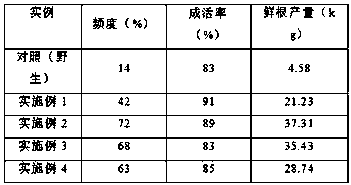Wild cultivation method of phlomis betonicoides
A technology of Gentiana chinensis and seeds, which is applied in the field of wild plant tending, can solve the problems of sustainable utilization of resources and unreported wild tending, and achieve the goals of sustainable development, utilization and protection, saving cultivated land, and increasing population size and yield Effect
- Summary
- Abstract
- Description
- Claims
- Application Information
AI Technical Summary
Problems solved by technology
Method used
Image
Examples
Embodiment 1
[0030] A kind of wild rearing method of Gentiana chinensis comprises the following steps:
[0031] (1) Regional selection: the original habitat of wild Gentiana chinensis in the arid valleys of Lancang River and Jinsha River at the junction of Yunnan, Sichuan and Tibet;
[0032] (2) Provenance preparation: Collect the seeds of Gentiana chinensis in September and excavate the rhizomes. After the seeds are air-dried, remove the unfulfilled seeds and save them for later use. They are used for direct sowing or breeding seedlings; after the rhizomes are excavated, store them in a cool and ventilated place. Section, using cutting roots to propagate seedlings; seedlings are propagated with floating trays or nutrient bowls, cutting roots are used to propagate seedlings with nutrient pots, and when transplanting, choose healthy and disease-free seedlings for planting;
[0033] (3) Planting: planting in March of the following year, by sowing seeds or transplanting seedlings; the amount ...
Embodiment 2
[0036] A kind of wild rearing method of Gentiana chinensis comprises the following steps:
[0037] (1) Regional selection: the original habitat of wild Gentiana chinensis in the arid valleys of Lancang River and Jinsha River at the junction of Yunnan, Sichuan and Tibet; the regional longitude and latitude range is N: 28°01′-29°57′, E: 98°38′-99 °20′, altitude 2000-3000m;
[0038] (2) Provenance preparation: collect the seeds of Gentiana chinensis in October and excavate the rhizomes. After the seeds are air-dried, remove the unfulfilled seeds and save them for later use. They are used for direct sowing or breeding seedlings; Section, using cutting roots to propagate seedlings; seedlings are propagated with floating trays or nutrient bowls, cutting roots are used to propagate seedlings with nutrient pots, and when transplanting, choose healthy and disease-free seedlings for planting;
[0039] The cutting root is the connection part between the aboveground stalk and the mature ...
Embodiment 3
[0049] A kind of wild rearing method of Gentiana chinensis comprises the following steps:
[0050] (1) Regional selection: the original habitat of wild Gentiana chinensis in the arid valleys of Lancang River and Jinsha River at the junction of Yunnan, Sichuan and Tibet; the regional longitude and latitude range is N: 28°01′-29°57′, E: 98°38′-99 °20′, altitude 2000-3000m;
[0051] (2) Provenance preparation: Collect the seeds of Gentiana chinensis and dig out the rhizomes from September to October. After the seeds are air-dried, remove the unfulfilled seeds and save them for later use. They are used for direct sowing or breeding seedlings; Forward cutting, use cutting roots to propagate seedlings; use floating trays or nutrient pots for seed propagation, and use nutrient pots for cutting root propagation seedlings, and choose healthy and disease-free seedlings for planting when transplanting;
[0052] The cutting root is the connection part between the aboveground stalk and th...
PUM
| Property | Measurement | Unit |
|---|---|---|
| Length | aaaaa | aaaaa |
Abstract
Description
Claims
Application Information
 Login to View More
Login to View More - R&D
- Intellectual Property
- Life Sciences
- Materials
- Tech Scout
- Unparalleled Data Quality
- Higher Quality Content
- 60% Fewer Hallucinations
Browse by: Latest US Patents, China's latest patents, Technical Efficacy Thesaurus, Application Domain, Technology Topic, Popular Technical Reports.
© 2025 PatSnap. All rights reserved.Legal|Privacy policy|Modern Slavery Act Transparency Statement|Sitemap|About US| Contact US: help@patsnap.com

